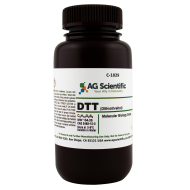Dithiothreitol [DTT] is also known as Cleland's Reagent. It contains two thiol groups and is commonly used to reduce disulfide bond in proteins. It can protect many thiol-containing biomolecules such as coenzyme A (Co-A), GSH (glutathione) from forming disulfide bonds. Not only does DTT scavenge the hydroxyl radical that attacks DNA and proteins, but also reacts with hydrogen peroxide that may generate hydroxyl radicals through the Fenton reaction.
![Chemical structure of Dithiothreitol [DTT]](/system/user_files/Images/C-1029%20structure%20AGS.jpg)
DTT is water-soluble and can readily permeate cell membrane. It contains two thiol groups and two hydroxyl groups. So, it is commonly used in biochemical research to protect sulfhydryl groups from oxidation or reduce disulfide linkages to free sulfhydryl groups in proteins and enzymes. Since the reversible formation of disulfide bonds is involved in many biological processes including protein activation and inactivation, regulation of gene expression, dithiothreitol may affect many biological processes by regulating protein activity.
Dithiothreitol [DTT] is widely used to reduce disulfide bonds in the analysis of protein structure and function. DTT has little tendency to be oxidized directly by air, so it has advantages to be a protective reagent compared to other thiol compounds. It is also a strong chelating reagent that can form specific and very stable polymeric and monomeric complexes with metal ions using its two thiol groups.
DTT is an unusually strong reducing agent, with a redox potential of -0.33 V at pH 7. The pKa of thiol groups is typically ~8.3. The reduction of a typical disulfide bond proceeds by two sequential thiol-disulfide exchange reactions. Adding DTT as a reducing agent to protein samples, sometimes might act as interference. To remove these interfering substances acetone or trichloroacetic acid is added to precipitate the proteins in the sample and separate from the interfering agents.
Applications
-
DTT is widely used in biochemical research to reduce disulfide bridges, protect biomolecules, in sample preparation, and to denature proteins before electrophoresis analysis (SDS-PAGE).
- DTT is frequently used to reduce the disulfide bonds of proteins and peptides. It prevents intramolecular and intermolecular disulfide bonds from forming between cysteine residues of proteins.
- DTT protects enzyme activity by the oxidation of sulfhydryl groups. As an antioxidant, it is used as a protective agent against ionizing radiations in living cells. It has been used to enhance or inhibit enzymes or receptors activity.
- The terminal sulfur atoms of thiolated DNA tend to form dimers in solution, especially in the presence of oxygen. Dimerization greatly lowers the efficiency of subsequent coupling reactions such as DNA immobilization on gold in biosensors. Typically, DTT is mixed with a DNA solution and allowed to react, and then is removed by filtration (for the solid catalyst) or by chromatography (for the liquid form).
- DTT can also be used as an oxidizing agent. Its principal advantage is that, effectively no mixed-disulfide species are populated, in contrast to other agents such as glutathione.
